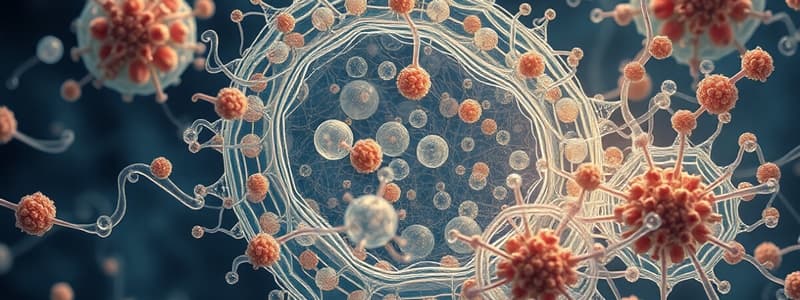Podcast
Questions and Answers
What best defines hypertrophy in cellular adaptations?
What best defines hypertrophy in cellular adaptations?
- Increase in cell numbers due to hormone stimulation
- Increase in cell size and organ size due to workload (correct)
- Replacement of one cell type with another differentiated cell type
- Decrease in cell size due to disuse
Which type of cellular adaptation involves increased cell numbers due to stimulation?
Which type of cellular adaptation involves increased cell numbers due to stimulation?
- Hypertrophy
- Metaplasia
- Hyperplasia (correct)
- Atrophy
What is the primary cause of intracellular accumulations according to metabolic disturbances?
What is the primary cause of intracellular accumulations according to metabolic disturbances?
- Excessive intake of substances (correct)
- Increased cellular respiration
- Reduced cellular apoptosis
- Decreased nutrient absorption
What is a characteristic morphology of irreversible cell injury?
What is a characteristic morphology of irreversible cell injury?
Which statement correctly describes apoptosis?
Which statement correctly describes apoptosis?
Which type of cell adaptation is characterized by a decrease in functional capacity due to reduced ability to repair damaged DNA?
Which type of cell adaptation is characterized by a decrease in functional capacity due to reduced ability to repair damaged DNA?
Which adaptation occurs when one differentiated cell type is replaced by another due to chronic irritation?
Which adaptation occurs when one differentiated cell type is replaced by another due to chronic irritation?
Which of the following statements is true regarding reversible cell injury?
Which of the following statements is true regarding reversible cell injury?
What morphologic change is commonly associated with aging cells?
What morphologic change is commonly associated with aging cells?
What is a major mechanism involved in cellular aging?
What is a major mechanism involved in cellular aging?
Which of the following types of injury is classified as irreversible?
Which of the following types of injury is classified as irreversible?
Which of the following is associated with the process of cellular swelling?
Which of the following is associated with the process of cellular swelling?
Which intracellular accumulation is linked with fatty liver disease?
Which intracellular accumulation is linked with fatty liver disease?
What is a characteristic morphologic response of malignant cells?
What is a characteristic morphologic response of malignant cells?
Which pigment is known as the 'aging pigment' found in cells?
Which pigment is known as the 'aging pigment' found in cells?
Flashcards are hidden until you start studying
Study Notes
Morphologic Response of the Cell
- Changes in cell shape due to various conditions.
- Response to stress varies between reversible injury, adaptation, and cell death.
Types of Cell Responses
Intracellular Accumulations
- Metabolic Disturbances cause abnormal material build-up inside cells.
- Triglycerides: Accumulates in cells, e.g., fatty liver.
- Cholesterol: Accumulates in macrophages and smooth muscle cells, contributing to atherosclerosis.
- Proteins: Immunoglobulins accumulate in plasma cells during immune responses.
- Glycogen: Accumulates in liver and muscle in glycogen storage diseases.
- Pigments:
- From outside the body or inside:
- Carbon (anthracosis): Black pigment that accumulates in the lungs.
- Lipofuscin (aging pigment): Yellow-brown pigment accumulating in aging cells.
- Iron (in hemosiderosis): Accumulates in various tissues due to iron overload.
- From inside the body: Forms pigments like bilirubin (in jaundice).
- From outside the body or inside:
Cellular Aging
- Morphologic and functional changes in cells due to a long lifespan.
- Caused by: Cellular damage accumulation, reduced DNA repair, reduced division capacity, altered protein homeostasis, and effects of high caloric intake.
- Morphological Responses: Abnormal nuclei, mitochondria, Golgi apparatus; decreased endoplasmic reticulum and ribosomes; accumulation of lipofuscin.
- Examples:
- Lipofuscin in neurons.
- Lipofuscin in cardiac muscle.
- Autophagy is the main mechanism of cellular aging.
- Cellular organelles are engulfed by cytoplasmic vacuoles that fuse with lysosomes to digest the engulfed organelle.
- Autophagy also occurs in cancers.
Cellular Adaptations
- Hypertrophy: Increased cell size due to increased workload or growth.
- Example: Hypertrophy of smooth muscle cells in the uterus during pregnancy.
- **Hyperplasia:**Increased cell number due to hormonal or growth factor stimulation.
- Example: Hormonal hyperplasia of the female breast during puberty.
- Atrophy: Decreased cell size due to reduced nutrient supply, blood flow, or disuse.
- Mechanism: Reduced protein synthesis and increased protein breakdown.
- Example: Senile brain atrophy.
- Metaplasia: Replacement of one differentiated cell type by another of the same category in response to chronic irritation.
- Purpose: Cells become better equipped to handle the stress.
- Example: Squamous metaplasia of respiratory epithelium in smokers.
Reversible Cell Injury
- Includes:
- Cellular swelling: Intracellular water accumulation, e.g., kidney tubules lining epithelium.
- Fatty change: Intracellular fat accumulation, e.g., hepatocytes.
- Morphology:
- Cell swelling.
- Cell membrane blebs.
- Mitochondrial swelling.
- Swelling of the endoplasmic reticulum.
- Cells retain their shape and can recover after injury.
Irreversible Cell Injury
- A- Necrosis: Death of a group of cells or tissues.
- Morphology:
- Cells become more eosinophilic.
- Nuclear dissolution.
- Breakdown of cell membranes, forming myelin figures.
- Digestion of cellular contents.
- Surrounding inflammation.
- Morphology:
- B- Apoptosis
- Programmed cell death to remove unwanted or damaged cells.
- Mechanism: Activation of caspases, fragmenting cells into apoptotic bodies, and phagocytosis of fragments.
- Pathways:
- Intrinsic pathway: Triggered by DNA damage or cellular stress.
- Extrinsic pathway: Triggered by death receptors on the cell surface.
Studying That Suits You
Use AI to generate personalized quizzes and flashcards to suit your learning preferences.




